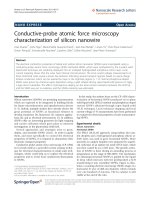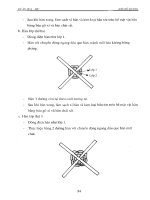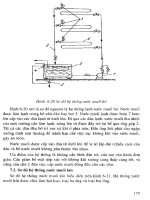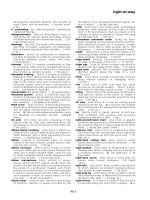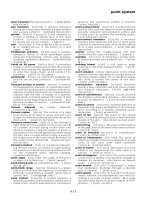Atomic Force Microscopy Episode 2 Part 8 pptx
Bạn đang xem bản rút gọn của tài liệu. Xem và tải ngay bản đầy đủ của tài liệu tại đây (333.98 KB, 20 trang )
AFM of
β
-Amyloid 349
349
26
Atomic Force Microscopy of β-Amyloid
Static and Dynamic Studies of Nanostructure and Its Formation
Justin Legleiter and Tomasz Kowalewski
1. Introduction
Ordered aggregation of the β-amyloid (Aβ) peptide in the brain as plaques
consisting of fibrils is an important characteristic of Alzheimer’s disease (AD),
a late onset neurodegenerative disease (1). Aβ derives from the endoproteolysis
of the amyloid precursor protein (APP), which is a transmembrane protein con-
taining 677–770 amino acids (2–9). The two most common forms of Aβ are
the 40 and 42 residues long fragments respectively referred to as Aβ(40) and
Aβ(42) (sequence shown in Fig. 1; ref. 10). The insoluble aggregated form of
Aβ, which deposits in the extra cellular space in the brain and on the walls of
cerebral blood vessels (6), exhibits an enhanced β-sheet conformation as
opposed to the partially α-helical soluble form found in body fluids (11,12).
Despite the lack of the definitive establishment of the causative role of Aβ in
AD, evidence points to its aggregation and deposition in the pathogenesis of AD.
The formation of the ordered, β-sheet rich fibrils is believed to proceed via
a slow nucleation-dependent mechanism that is followed by rapid “chain-
growth” into protofibrils that eventually elongate and possibly coalesce to form
mature amyloid fibrils (Fig. 2; refs. 7,13–17). The elongation of the protofibrils
and fibrils appears to be of the first order (7,13,16,17). The slow step is the
formation of Aβ oligomers that nucleate the process, but it is unclear what
causes the formation of these small oligomers. It appears that a critical local
concentration needs to be achieved. Such conditions can occur as the result of
inefficient clearance of Aβ from the brain. Intra- and extracellular surfaces
located inside the brain could also play a pivotal role by increasing local con-
centrations of Aβ to facilitate the formation of a stable nucleus. Understanding
how the process of fibrillogenesis is nucleated and how it is facilitated could
From:
Methods in Molecular Biology, vol. 242: Atomic Force Microscopy: Biomedical Methods and Applications
Edited by: P. C. Braga and D. Ricci © Humana Press Inc., Totowa, NJ
350 Legleiter and Kowalewski
offer valuable insights into possible targets along the disease pathway for novel
treatments for AD.
Atomic force microscopy (AFM) can be used to image and study Aβ with
resolution comparable to that achievable with transmission election micros-
copy (TEM). However, it does not require the extensive sample preparations,
such as staining, that precludes the use of TEM in kinetic studies and could
possibly alter the morphology of the Aβ fibrils. AFM can also obtain more
complete 3D information than can be derived from the 2D cross sectional pro-
files obtained in TEM studies. In situ tapping-mode AFM (18,19) under liq-
uids offers the ability to study Aβ fibrilization under physiological conditions
in a time-dependent manner, which allows the monitoring of changes in con-
formation and aggregation of Aβ (20). AFM can also be used to gain insights
into the interaction of Aβ with other materials that are of potential importance
in AD that could either inhibit or promote Aβ self-assembly into fibrils. This
type of information would be useful in evaluating specific drugs designed to
inhibit the process and in the determination of where along the pathway they
interact with Aβ. These types of studies could also lead to understanding of
how other relevant factors (such as lipoproteins, lipid bilayers) affect fibril
formation.
Fig. 1. The sequence of Aβ peptide (10).
Fig. 2. A simple nucleation dependent mechanism for the growth of Aβ fibrils. A
series of unfavorable protein-protein association equilibria with rate constant K
n
lead
to the formation of a stable nucleus. Once the nucleus is formed, growth into a fibril is
achieved by a series of favorable equilibria with rate constant K
g
. This shift from the
unfavorable to favorable equilibria results in a critical concentration phenomenon.
Once a stable nucleus is formed, fibril growth is first order (17). With permission,
from the Annual Review of Biochemistry, Volume 66 1997 by Annual Reviews
www.annualreviews.org.
AFM of
β
-Amyloid 351
2. Materials
1. AFM capable of performing in situ operations. There are several systems com-
mercially available from different vendors (Digital Instruments-Veeco, JEOL,
Molecular Imaging, Omicron, Pacific Scanning, Quesant Instrument Corpora-
tion, Accurion Scientific Instruments, Asylum Research).
2. Standard contact mode fluid cell or fluid cell with piezoelectric accuator.
3. Low-spring-constant cantilever probes, for example, 100-µm wide-legged sili-
con nitride cantilevers with nominal spring constant of 0.58 N/m for in situ tap-
ping mode atomic force microscopy (TMAFM) (commercially available from
several vendors: Digital Instruments, Olympus, Bioforce).
4. Tapping mode. Tapping mode-etched silicon probes for ex situ studies. (Com-
mercially available from several vendors: Digital Instruments, Olympus,
Bioforce.)
5. Dimethylsulfoxide (DMSO).
6. Trifluoroacetic acid (TFA).
7. Phosphate-buffered saline (PBS) buffer of approx pH 7.4.
8. Mica.
9. Highly ordered pyrolitic graphite.
10. Aβ(40, 42), or other fragments that are commonly available from several vendors.
11. Nitrogen.
12. Ultra pure water.
3. Methods
The methods section discusses experimental topics (see Note1) such as
preparation, handling, and incubation of Aβ samples (see Note 2), ex situ AFM
studies of Aβ (see Note 3), in situ AFM studies of Aβ (see Note 4), common
methods of analyzing data obtained form AFM studies of Aβ (see Note 5), and
incorporating other factors into AFM studies of Aβ (see Note 6).
3.1. Preparation and Handling of A
β
Samples
3.1.1. Storage
1. Several different solvents can be used to prepare stock solutions of Aβ. Eventu-
ally, these stock solutions should be dissolved in a physiological buffer, such as
phosphate-buffered saline (PBS) or Tris-HCl. Solvents that have been used to
dissolve Aβ include dimethylsulfoxide (DMSO) (21,22), TFA (14), acetic acid
(23), chloroform (24), physiological buffer (25,26), and deionized water (3,27).
DMSO appears to be the most commonly used solvent, and the following proce-
dure will involve the use of DMSO.
2. Aβ is easily dissolved in DMSO, and it can be used to make stock solutions that
can be stored at –20°C for extended periods of time. Care should be taken to
obtain accurate knowledge of the concentration of these stock solutions (usually
2–10 mM but this can vary). The stock solutions can also be filtered to remove
any fibril seeds that may be present (21), but a larger initial concentration is
352 Legleiter and Kowalewski
needed for this so that the final concentration remains in the approximate range
indicated above.
3. Also, an independent method needs to be used to analyze the concentration of the
stock solution after filtration since the removal of seeds will reduce the amount of
Aβ in solution. This can be accomplished by quantitative amino acid analysis (21).
4. It is also useful to store the Aβ stock solution in smaller aliquots that will be used
for individual experiments. The size of these aliquots depends on the concentra-
tion of the stock solution and the desired concentration for experiment once the
stock solution is dissolved in physiological buffer as will be discussed in Sub-
heading 3.1.2., step 1. This prevents waste and possible complications that may
arise because of several cycles of thawing and refreezing stock solutions. Since
these stock solutions are going to be dissolved into physiological buffer, it is
important to keep the stock solutions concentrated enough so that upon dilution
in the buffer the DMSO is diluted to less than 0.1% of the total volume. This
limits the effect that the DMSO may have on the observed behavior of the Aβ in
the study.
3.1.2. Incubation
1. In order to initiate the fibril formation, aliquots of the stock Aβ solution in DMSO
need to be dissolved in physiological buffer. The new solution should be gently
vortexed for approx 60 s to ensure thorough mixing. In order to ensure the solu-
bility of the Aβ into physiological buffer, the buffer can initially be heated to
approx 37°C prior to the addition of the DMSO Aβ stock solution.
2. Once the Aβ stock solution is dissolved in the buffer, the temperature should be
held at 37°C for approximately another 30 min. These prepared incubation
samples can range in concentration from 5–500 µM. Lower concentrations may
inhibit the formation of fibrils or may inhibit the ability to observe fibrils due to
concentration depletion associated with aggregation of Aβ along the surfaces of
the container.
3. Incubation of these samples can last from a few minutes to days and can be car-
ried out at room temperature. These incubating samples should not be perturbed
except to obtain aliquots for imaging to prevent the possibility of disrupting the
process of self-assembly into fibrils.
4. Variation of the incubation process can easily be achieved by adding different
elements to the Aβ solution, such as fibril seeds (28) or known amyloid inhibitors
or promoters (25). Also, different pH, temperature (21), concentration, and other
conditions can easily be varied.
3.2.
Ex Situ
Studies of A
β
1. Ex situ AFM experiments have provided many insights into the fibrillization of
Aβ (21,23,28,29) (see Notes and Fig. 3) and are especially useful as a comple-
ment to other techniques used to study the aggregation and self-assembly of Aβ.
The major limitation of this technique is sample preparation, which ultimately
AFM of
β
-Amyloid 353
carries the sample through a range of nonphysiological conditions, potentially
leading to the perturbation of the original structure.
2. Moreover, ex situ AFM studies do not allow for the study of the development of
the same Aβ structure over time that is possible, as will be discussed in Sub-
heading 3.3., with in situ AFM studies. However, by preparing several different
aliquots from the same incubation at different time intervals, the development of
protofibrils to mature fibrils can still be observed and studied.
3. Ex situ AFM is especially useful for observing changes in Aβ fibrillogenesis over
extended periods of time (days).
3.2.1. Deposition
1. Deposition of Aβ onto a substrate for imaging is an important aspect of ex situ
studies. Care must be taken to make the deposition process as noninvasive as
possible as well as to reproducibly deposit the sample onto the surface. To ensure
this, strict protocol should be used to deposit the sample onto the substrate.
2. To optimize the deposition process, concentrations can be adjusted to increase
and decrease the amount of deposited peptide found on the surface.
3. The following is a brief procedure for depositing Aβ samples onto mica.
a. Aliquots of 2–5 µL of incubated Aβ solution should be placed on freshly
cleaved mica. Marking the backside of the mica with a small dot for sample
placement is useful for locating the deposited Aβ later during imaging.
b. The droplet is then left on the substrate for approx 30 s to 2 min, depending on
the concentration of solution and the desired coverage. Once optimal condi-
tions are found, the time the sample is allowed to incubate on the substrate
should be held constant between depositions.
c. After incubating the aliquot on the mica, the sample should be washed with
50–200 µL of ultra pure water to remove excess salts and unbound peptide. It
is useful to tilt the substrate and deposit the wash above the sample on the
Fig. 3. Ex situ AFM images of an Aβ sample deposited on mica at different time
intervals (2, 7, and 18 d). Each image is 500 nm by 500 nm. The development of longer
protofibrils can be seen as the sample was allowed to incubate for longer times (28).
Reprinted with permission from ref. 21. Copyright 1999 American Chemical Society.
354 Legleiter and Kowalewski
mica. Then, the wash can gently flow past the deposited peptide. This reduces
the risk of damaging the deposited Aβ structures when applying the wash.
d. Allow the samples to dry under a gentle stream of nitrogen to prevent con-
tamination and speed the drying process.
e. Once the mica is dry, the sample can be mounted onto a puck and imaged.
Samples should be imaged as soon as possible to prevent any contamination
or degradation over time.
3.2.2. Chemically Immobilized A
β
Deposition
1. Ex situ studies have also been carried out on thiol-based immobilization of Aβ on
flat gold surfaces (23). Vapor deposition on mica can be used to prepare the gold
substrates. After rinsing the substrates with ethanol, the gold substrate can be
immersed in a 1 mM solution of 11-mercaptoundecanoic acid or a mixed solution
of 11-mercaptoundecanoic acid and 3-mercaptopropionic acid (1 : 10).
2. The gold substrate should be soaked overnight and then placed in an aqueous solu-
tion of 1-ethyl-3-(3dimethlylaminopropyl)-carbodiimide (75 mM) and N-hydroxy-
succinimide (15 mM) for 5 min.
3. After this, the substrates can be soaked in the diluted amyloid solutions for up to
an hour. The substrates should be rinsed with deionized water after removal from
the amyloid solution and allowed to dry. The substrates should be stored under
argon.
3.3.
In Situ
Studies of A
β
1. In situ TMAFM has been successfully applied to the study of Aβ aggregation and
fibrillization (22,26). This technique offers the unique opportunity to image the
fibrillization process in a dynamic way, and it can be used to study the interac-
tions of Aβ with other important factors implicated in AD (14,24,25).
2. It can also be used in conjunction with other techniques used to study Aβ. These
techniques include circular dichroism (14,25,30), fluorescence (30), and absor-
bance (30). It should be noted that the concentration of incubating Aβ solutions
may need to be decreased. If the concentration is too large, the surface will be
crowded, and the measurement of dimensions for individual particles will become
difficult. However, the larger concentration of the incubating samples is also
important to prevent the depletion of the sample from aggregation on the walls of
the container and also to facilitate the fibrilization process. The concentration
used for imaging needs to be systematically optimized.
3.3.1. Choice of Substrate
1. The choice of substrate to be used in the experiment is extremely important.
Because of differing hydrophobicity and hydrophilicity of different surfaces, dif-
ferent effects on Aβ can be observed. The surface interactions play a significant
role in aggregation and deposition, and thus in the self-assembly of Aβ into fibril-
lar species.
AFM of
β
-Amyloid 355
2. Two commonly used substrates are mica and highly ordered pyrolitic graphite
(HOPG) which can easily be cleaved to provide atomically flat surfaces.
3. Contrast between interaction of hydrophilic mica (Fig. 4) and hydrophobic graph-
ite (Fig. 5) can also offer insights into the specific interactions that lead to Aβ
self-assembly. The surface of mica is negatively charged in solution. Due to this
negative charge, mica can be thought of as a surface that models the exterior of
anionic phospholipid membranes. The interiors of phospholipid bilayers and
lipoprotein particles can be modeled by the hydrophobic surface of graphite.
3.3.2. Imaging of Aliquots
Similar to the procedure briefly described in ex situ AFM experiments in
Subheading 3.2., aliquots of the same incubating sample can be imaged after
different times to monitor the self assembly of Aβ into fibrils.
3.3.3. Time Lapse Imaging
1. In situ AFM can be used to study dynamic biological processes, including
fibrilization, by time lapse imaging (20), which allows observation of the initial
aggregation of Aβ into protofibrils and the elongation of these protofibrils into
mature fibrils (Fig. 6). In this technique, a freshly prepared sample is imaged in
the same area of the surface at different time intervals, which can be hours in
duration.
Fig. 4. 3D rendering of in situ AFM image of Aβ(42) on the hydrophilic surface of
mica. This image was taken in PBS buffer with a peptide concentration of 500 µM.
The surface is covered with globular and protofibrillar aggregates of Aβ. The hydro-
philic mica can be viewed as a model of the exterior of phospholipid bilayers that
constitute cell membranes (22).
356 Legleiter and Kowalewski
Fig. 5. 3D rendering of in situ AFM image of Aβ(42) on graphite. The sample was
imaged in PBS buffer. The ribbon-like assemblies of Aβ preferentially orient along
AFM of
β
-Amyloid 357
2. It is important to maintain a good seal between the fluid cell and surface to prevent
the evaporation of the solution. By monitoring the same area at different time inter-
vals, it becomes possible to identify and track the development of individual fibrils,
and to measure the rate of their elongation and detect morphological changes. Such
direct observations provide insights into the mechanisms by which Aβ fibrils nucle-
ate and grow. These insights may be then used in the determination of where along
the pathway a specific compound may interfere with the fibril growth.
Fig. 5. (continued) crystallographic directions of graphite, presumably maximizing
hydrophobic interaction with the surface. Hydrophobic graphite can be viewed as a
model of the interior of phospholipid bilayers and the core of lipoprotein particles.
The average lateral spacing of the aggregates is 18.8 ± 1.8 nm. The schematic illus-
trates the orientation of peptide chains in the aggregates based on their dimensions
(bottom). The height of the aggregates above the graphite surface ranged from 1.0–1.2 nm.
The dimensions of Aβ aggregates on graphite strongly suggest that Aβ adopts a
β-sheet form with peptide chains perpendicular to the long axis of the ribbon (22).
Fig. 6. In situ tapping mode AFM makes it possible to track the early steps of Aβ
fibrillization. The above 1-µm by 1-µm images track the Aβ aggregates as they form
protofibrils and elongate. (A and B) Images tracking the formation of a protofibril from
two Aβ aggregates and the elongation of the protofibril by further addition of Aβ aggre-
gates. (C) An Aβ protofibril is shown to elongate in two directions by the further addi-
tion of Aβ aggregates. From ref. 26. Copyright 2000, with permission from Elsevier.
358 Legleiter and Kowalewski
3.4. Quantitative Analysis of AFM Images
1. Quantitative analysis of AFM images can easily be carried out with the aid of computer
programs designed to measure heights, diameters, volumes and numbers of particles.
2. In such analysis, it is important to take into account the finite size and shape of
the tip used in the experiment, since it may significantly contribute to the
observed dimensions of imaged objects.
3. In time lapse in situ AFM, the tip contribution may remain relatively constant,
provided that the tip is not damaged and that peptide molecules are not aggregat-
ing on the tip changing its size and shape. Hence when comparing results from
different experiments, variability between the tips should be considered.
4. Common methods for tip characterization include the use of tip characterizers
(31) and blind tip reconstruction (32).
5. A simple quantitative measurement involves monitoring the number of objects
per unit area as a function of time (Fig. 7; 21,22,26). Different types of objects
(i.e., oligomers, protofibrils, or mature fibrils) can be differentiated by a charac-
teristic physical parameter like height or diameter (Figs. 7–8; 22,26).
6. Analysis of the population of these different forms of Aβ has shown that smaller
aggregates tend to disappear as large protofibrils and mature fibrils are formed,
indicating that smaller aggregates of Aβ are coalescing to form the larger struc-
tures (21,22,26).
7. Comparisons of these populations with the change in an average physical param-
eter (like diameter) also show if these particles are aggregating and coalescing
into larger assemblies. A change in the average height or effective diameter of
adsorbed material can also indicate different regimes of growth if plotted as a
function of time (Fig. 8; 22).
8. Elongation rates can also be measured by an average measurement of fibril
lengths as a function of time from aliquots of the same incubation or by the change
in length of individual protofibrils as observed in time lapse AFM (Fig 9; 21,26).
3.5. Incorporating Other Factors into AFM Studies of A
β
1. Once optimal conditions for imaging Aβ are determined, other variables can be
added to gain insight into more specific interactions controlling fibrillization.
For instance, the effects of glycerol and trimethylamine N-oxide, which act as
chemical chaperones in the amyloid pathway, on the fibrillization of Aβ have
been studied using in situ AFM (25).
2. AFM has also been used to study soluble Aβ oligomers by altering solution con-
ditions (30). These oligomers may be important as intermediates between the
monomeric form and the fibrillar form of Aβ and may be themselves physiologi-
cally active (30). The interaction of Aβ with planar bilayers of total brain lipid
extract and DMPC deposited on a mica surface has also been reported (14).
3. The effects of Aβ on endothelial cells have been studied by imaging cells incu-
bated with Aβ present (24). The Aβ was not directly observed in these images of
endothelial cells. Rather, the vitality of the cell was monitored using AFM for
cells that had been incubated with and without Aβ.
AFM of
β
-Amyloid 359
4. Notes
1. The choice of surface for AFM studies of Aβ is important in gaining insight into
the role of surface interaction in the pathway of amyloid formation. Intra- and
extracellular surfaces in the brain may play a role in the fibrilization of Aβ. Dif-
ferent surfaces can model different aspects of surfaces found in vivo. Mica is a
Fig. 7. Quantitative analysis of the aggregation of Aβ(42) on mica can be accom-
plished by studying the number of particles present in an area as a function of time.
Comparison to some physical parameter (effective thickness in this instance) as a func-
tion of time can aid in determining quantitatively the aggregation of Aβ. In the above
plots, it is shown that the number of individual aggregates of Aβ decreases as the
effective thickness of the aggregates (corresponding to total volume) increases. This
indicates that aggregates on the mica surface merge to form larger aggregates as a
function of time (22).
360 Legleiter and Kowalewski
hydrophilic surface and can be used to model the outside of cell surfaces that are
primarily composed of the hydrophilic head groups of phospholipids. Graphite,
which is hydrophobic, can be used to model the interior of the lipid bilayers that
Fig. 9. The temperature dependence of protofibril growth is studied by tracking the
longest protofibril as a function of time at various temperatures (left) using ex situ
AFM. An arrhenius plot can be constructed from data of the longest protofibril. The
plot on the right shows an Arrhenius plot constructed form data taken at two days
for Aβ samples incubated at different temperatures. Reprinted with permission from
ref. 21. Copyright 1999 American Chemical Society.
Fig. 8. Quantitative analysis of Aβ aggregation on graphite is accomplished by
plotting effective diameter as a function of time for an in situ AFM experiment. The
plot shows the appearance of an incubation time as well as two separate regimes of
growth (22).
AFM of
β
-Amyloid 361
make up cell membranes. Different characteristics of aggregation have already
been observed in situ using AFM for these surfaces (Figs. 4–5). An important
step towards more physiologically relevant surfaces has been recently made
through the use of supported lipid bilayers (14). Substrates can provide insights
into the potentially disruptive interactions of Aβ with cell membranes (14).
2. Aβ(42) has been shown to form fibrils at a higher rate than Aβ(40) (7,33). The
difference between fibril formation by these two fragments could provide insights
into an overall mechanism of the process. The different rates exhibited by the
two different Aβ fragments can be taken advantage of in experimental design.
For instance, the faster initial rate of Aβ(42) to form fibrils decreases the amount
of time needed to observe the transformation of Aβ populations containing mostly
protofibrils to a population containing mature fibrils. Conversely, Aβ(40), with
its slower initial elongation rate, may be valuable in studying the initial forma-
tion of protofibrils and other Aβ oligomers that may be important in the amyloid
pathway.
3. Ex situ AFM studies support the formation of protofibrils as an intermediate to
the formation of mature amyloid fibrils, as protofibrils (3 nm by 20–70 nm) were
observed and eventually disappeared as mature fibrils were formed (29). Subse-
quent ex situ AFM experiments showed that the formation of amyloid fibrils could
be seeded by preformed fibrils, indicating the importance of nucleation (28).
Another ex situ AFM study has shown that the elongation process of fibrilization
is first order (21), and a different ex situ AFM experiment revealed protofibrils
that were composed of individual aggregates of Aβ (23).
4. In situ AFM studies provide the unique opportunity to study Aβ fibrilization
under physiological conditions at different stages of fibrillogenesis. This tech-
nique is useful for imaging initial aggregates of Aβ, the formation of protofibrils,
and the maturation of fibrils. It has been shown that under physiological condi-
tions, in contact with hydrophilic surfaces, Aβ will form 5–6 nm tall particulate
aggregates that eventually form protofibrils (Fig. 4; 22). On hydrophobic sur-
faces, Aβ forms elongated approx 1 nm tall and approx 19 nm wide ribbons (Fig.
5; 22). In situ AFM studies have also been used to show the growth of protofibrils
into mature fibrils over time (Fig. 6; 22,26).
5. Due to viscous damping when imaging in fluids, the mechanical quality factor,
Q, of the cantilever is significantly reduced, resulting in larger imaging forces
(tapping forces). The forces associated with imaging could disturb fragile aggre-
gates or even inhibit their formation. Furthermore, tapping forces could be espe-
cially important in the studies of the interaction of Aβ with other molecules, such
as potential drugs, since they could perturb or disrupt the interaction. In order to
limit the invasiveness of the probe used to image Aβ and its interactions with
other molecules in situ, the force used needs to be minimized. It has been demon-
strated recently that tapping forces can be significantly reduced through the use
of active resonance Q control (34–37). The lower force makes it possible to study
weak interactions that are otherwise disrupted by the large forces normally asso-
ciated with in situ imaging. Active Q control instrumentation is now commer-
362 Legleiter and Kowalewski
cially available from different vendors (38,39). Lowering the tapping force could
also open the way to the use of sharper tips (such as carbon nanotubes), by reduc-
ing the pressure exerted by the sharper tips on the samples, and the possibility of
damage to the tips themselves.
6. Another important consideration when using in situ tapping mode AFM is the
mode of excitation of the cantilever. There are currently two commonly used
methods, acoustic excitation (18,19) and magnetic excitation (40,41). Acoustic
excitation uses the sound waves produced by vertical oscillation of the piezoelec-
tric scanner (18,19). In magnetic excitation, a magnetically coated cantilever is
oscillated by passing an alternating current through the solenoid located in the
vicinity of the cantilever (40,41). The advantage of this mode is that it does not
rely on oscillation of the liquid, which could be potentially disturbing to the
sample. Acoustic excitation is more economical since it does not require expen-
sive magnetically coated tips.
Acknowledgments
Financial support from NIH (P50-AG05681) and from Carnegie Mellon
University (start-up grant to T.K.) is gratefully acknowledged.
References
1. Dickson, D. (1997) The pathogenesis of senile plaques. J. Neuropathol. Exp.
Neurol. 56, 321–339.
2. Selkoe, D., Abraham, C., Podlisny, M., and Duffy, L. (1986) Isolation of low-
molecular-weight proteins from amyloid plaque fibers in Alzheimer’s disease.
J. Neurochem. 146, 1820–1834.
3. Zhu, Y. J., Lin, H., and Lal, R. (2000) Fresh and nonfibrillar amyloid β protein
(1– 40) induces rapid cellular degeneration in aged human fibroblasts: evidence
for AβP-channel-mediated cellular toxicity. FASEB J. 14, 1244–1254.
4. Goedert, M., Trojanowski, J., and Lee, V Y. (1996) The neurofibrillary pathol-
ogy of Alzheimer’s disease, in The Molecular and Genetic Basis of Neurological
Disease, 2nd ed. (Rosenberg, R., Prusiner, S., DiMauro, S., and Barchi, R., eds.)
Butterworth-Heinemann, Boston, MA, pp. 613–627.
5. Masters, C., Simms, G., Weinman, N., Multhaup, G., McDonald, B., and
Beyreuther, K. (1985) Amyloid plaque core protein in Alzheimer disease and
Down syndrome. Proc. Natl. Acad. Sci. USA 82, 4245–4249.
6. Lansbury, P. T., Jr. (1996) A reductionist view of Alzheimer’s disease. Acc. Chem.
Res. 29, 317–321.
7. Jarrett, J. T., Berger, E. P., and Lansbury, P. T. (1993) The carboxy terminus of β
amyloid protein is critical for the seeding of amyloid formation: implications for
the pathogenesis of Alzheimer’s disease. Biochemistry 32, 4693–4697.
8. Roher, A., Wolfe, D., Palutke, M., and KuKuruga, D. (1986) Purification, ultra-
structure, and chemical analysis of Alzheimer disease amyloid plaque core pro-
tein. Proc. Natl. Acad. Sci. U.S.A. 83, 2662–2666.
AFM of
β
-Amyloid 363
9. Esch, F., Keim, P. S., Beattie, E. C., Blacher, R. W., and Culwell, A. R. (1990)
Cleavage of amyloid β peptide during constitutive processing of its precursor.
Science 248, 1122–1128.
10. Selkoe, D. J. (1993) Physiological production of the β-amyloid protein and the
mechanism of Alzheimer’s disease. Trends Neurosci. 16, 403–409.
11. Kelly, J. W. (1998) The alternative conformations of amyloidogenic proteins and
their multi-step assembly pathways. Curr. Opin. Struct. Biol. 8, 101–106.
12. Smith, M. A. (1998) Alzheimer disease. Int. Rev. Neurobiol. 42, 1–54.
13. Naiki, H. and Nakakuki, K. (1996) First-order kinetic model of Alzheimer’s
β-amyloid fibril extension in vitro. Lab. Invest. 74, 374–383.
14. Yip, C. M. and McLaurin, J. (2001) Amyloid-β peptide assembly: a critical step
in fibrillogenesis and membrane disruption. Biophys. J. 80, 1359–1371.
15. Lomakin, A., Chung, D. S., Benedek, G. B., Kirschner, D. A., and Teplow, D. B.
(1996) On the nucleation and growth of amyloid β-protein fibrils: detection of
nuclei and quantitation of rate constants. Natl. Acad. Sci. USA 93, 1125–1129.
16. Esler, W. P., Stimson, E. R., Ghilardi, J. R., et al. (1996) In vitro growth of
Alzheimer’s disease β-amyloid plaques displays first-order kinetics. Biochemis-
try 35, 749–757.
17. Harper, J. D. and Lansbury, J., P.T. (1997) Models of amyloid seeding in Alzheimer’s
disease and scrapie: mechanistic truths and physiological consequences of the time-
dependent solubility of amyloid proteins. Annu. Rev. Biochem. 66, 385–407.
18. Putman, C. A. J., Van Der Werf, K. O., De Grooth, B. G., Van Hulst, N. F., and
Greve, J. (1994) Tapping mode atomic force microscopy in liquid. Appl. Phys.
Lett. 64, 2454–2456.
19. Hansma, P. K., Cleveland, J. P., Radmacher, M., et al. (1994) Tapping mode
atomic force microscopy in liquids. Appl. Phys. Lett. 64, 1738–1740.
20. Goldsbury, C., Kistler, J., Aebi, U., Arvinte, T., and Cooper, G. J. S. (1999)
Watching amyloid fibrils grow by time-lapse atomic force microscopy. J. Mol.
Biol. 285, 33–39.
21. Harper, J. D., Wong, S. S., Lieber, C. M., and Lansbury, P. T. (1999) Assembly of
aβ amyloid protofibrils: an in vitro model for a possible early event in Alzheimer’s
disease. Biochemistry 38, 8972–8980.
22. Kowalewski, T. and Holtzman, D. M. (1999) In situ atomic force microscopy
study of Alzheimer’s β-amyloid peptide on different substrates: new insights into
mechanism of β-sheet formation. Proc. Natl. Acad. Sci. USA 96, 3688–3693.
23. Blackley, H. K. L., Patel, N., Davies, M. C., et al. (1999) Morphological develop-
ment of β(1-40) amyloid fibrils. Exp. Neurology 158, 437–443.
24. Lin, H., Bhatia, R., and Lal, R. (2001) Amyloid β protein forms ion channels:
implications for Alzheimer’s disease pathophysiology. FASEB J. 15, 2433–2444.
25. Yang, D. S., Yip, C. M., Jackson Huangi, T. H., Chakrabarttyi, A., and Fraser, P.
E. (1999) Manipulating the amyloid-β aggregation pathway with chemical chap-
erones. J. Bio. Chem. 274, 32,970–32,974.
26. Blackley, H. K. L., Sanders, G. H. W., Davies, M. C., Roberts, C. J., Tendler, S. J.
B., and Wilkinson, M. J. (2000) In-situ atomic force microscopy study of β-amy-
loid fibrillization. J. Mol. Biol. 298, 833–840.
364 Legleiter and Kowalewski
27. Bhatia, R., Lin, H., and Lal, R. (2000) Fresh and globular amyloid β protein
(1–42) induces rapid cellular degeneration: evidence for AβP channel-mediated
cellular toxicity. FASEB J. 14, 1233–1243.
28. Harper, J. D., Wong, S. S., Lieber, C. M., and Lansbury, P. T. (1997) Atomic
force microscopy imaging of seeded fibril formation and fibril branching by the
Alzheimer’s disease amyloid-β protein. Chem. Biol. 4, 951–959.
29. Harper, J. D., Wong, S. S., Lieber, C. M., and Lansbury, P. T. (1997) Observation
of metastable Aβ amyloid protofibrils by atomic force microscopy. Chem. Biol. 4,
119–125.
30. Jackson Huang, T. H., Yang, D. S., Plaskos, N. P., et al. (2000) Structural studies of
soluble oligomers of the Alzheimer β-amyloid Peptide. J. Mol. Biol. 297, 73–87.
31. Xu, S. and Ansdorf, M. F. (1994) Calibration of scanning (atomic) force micro-
scope with gold particles. J. Microscopy 173(Pt. 3), 199–210.
32. Villarrubia, J. S. (1997) Algorithms for scanned probe microscope image
simulation, surface reconstruction, and tip estimation. Natl. Inst. Stand. Technol.
102, 425.
33. Cai, X. D., Golde, T. E., and Younkin, S. G. (1993) Release of excess amyloid β
protein from a mutant amyloid β protein precursor. Science 259, 514–516.
34. Tamayo, J., Humphris, A., and Miles, M. (2001) High-Q dynamic force micros-
copy in liquid and its application to living cells. Biophys. J. 81, 526–537.
35. Humphris, A., Tamayo, J., and Miles, M. (2000) Active quality factor control in
liquids for force spectroscopy. Langmuir 16, 7891–7894.
36. Tamayo, J., Humphris, A., and Miles, M. (2000) Piconewton regime dynamic
force microscopy in liquid. Appl. Phys. Lett. 77, 582–584.
37. Humphris, A., Round, A., and Miles, M. (2001) Enhanced imaging of DNA via
active quality factor control. Surface Science 491, 468–472.
38. Infinitesima Limited. Bristol, UK. />39. Asylum Research. Santa Barbara, CA. />40. Lantz, M. A., O’Shea, S. J., and Welland, M. E. (1994) Force microscopy imag-
ing in liquids using ac techniques. Appl. Phys. Lett. 65, 409–411.
41. Han, W., Lindsay, S. M., and Jing, T. (1996) A magnetically driven oscillating
probe microscope for operation in liquids. Appl. Phys. Lett. 69, 4111–4113.
Cantilever Used as a Biosensor 365
365
27
How to Build Up Biosensors With the Cantilever
of the Atomic Force Microscope
Ricardo de Souza Pereira
1. Introduction
With the advent of the atomic force microscopy (AFM), the study of biologi-
cal samples has become more realistic because, in most cases, samples are not
covered or fixed and this makes it possible to observe them while alive (1,2).
This advantage of the AFM prompted a new invention: nanobiosensors using the
cantilever (probe) of the AFM, which made possible the observation of specific
molecules (including medications) as they enter or exit living cells (3,4).
The nanobiosensor is the smallest biosensor in the world and measures about
100-µm long (about the width of a hair). Beyond sensing the area of interest,
this biosensor also makes possible a real-time image of exactly what is occuring
on the cell (3,4).
1.1. Use of the AFM as a Heat Detector
An apparatus for measuring variation of temperature is the thermooptical
detector. A reaction cell, whose bottom is a thin gold film (with immobilized
enzyme), is immersed into a CCl
4
phase where a probe beam is passed. The
heat (from reaction between the enzyme and its substrate) of the water phase is
transferred to the gold film and the CCl
4
phase, and thus a temperature gradient
is generated in the CCl
4
phase. This temperature gradient induces deflection of
the probe beam and the result is registered as a graph (3–9).
Because AFM has almost the same parts as the thermooptical detector (laser
beam, lens, and photodiode; refs. 3 and 4), if an enzyme was immobilized on
the cantilever, one can hope that the temperature gradient generated by reac-
tion heat (between the enzyme and its substrate) could induce a deflection of
the cantilever, transforming the AFM into an apparatus that could reveal the
presence of specific molecules.
From:
Methods in Molecular Biology, vol. 242: Atomic Force Microscopy: Biomedical Methods and Applications
Edited by: P. C. Braga and D. Ricci © Humana Press Inc., Totowa, NJ
366 de Souza Pereira
As mentioned before, an AFM equipped with an enzyme-coated cantilever
(nanobiosensor) can visualize living cells, so it should be possible to detect
specific molecules being absorbed by living cells and to see this happening.
These assumptions were shown to be valid by experiments made with the first
nanobiosensor, which had been made to detect the absorption of glucose mol-
ecules by Saccharomyces cerevisiae cells (3).
The deflection of the cantilever is explained by the physical phenomenon
occurring when two different metal blades (each with a different coefficient of
dilation) are bonded together. This is called a bimetallic system, and the pres-
ence of heat makes the blades bend. Another illustration of the phenomenon is
the working of the taillights of an automobile: a bimetallic blade is heated until
it bends and produces a braking light (4). The cantilever of AFM is not a bime-
tallic blade but can work as one because it consists of two different materials (a
metal and semimetal) with different dilation coefficients: gold and silicon. If a
biochemical (or chemical) reaction takes place near this so-called bimetallic
blade, it is possible to produce a deflection in the cantilever. This latter pro-
duces an enormous deviation in the direction of the laser beam, which is
recorded in real time by the computer (via a photodiode; ref. 4).
Beyond observing the absorption of glucose molecules by living cells, it
was possible to visualize the inverted phenomenon: the release of specific mol-
ecules from living cells immobilized on the cantilever surface, in the first instance
of this technique, the enzyme alcohol dehydrogenase type II, which transforms
ethyl alcohol into glutaraldehyde and releases heat in the process (4).
Other biosensors were made using the enzymes superoxide dismutase and
catalase (4), proving that this methodology is valid for all enzymes or mol-
ecules that release heat from their reactions.
1.2. Identifying Defective Genes
Tiny variations in the genetic code are what make us unique. Changes in one
chemical unit in a gene’s sequence, called single nucleotide polymorphisms,
can influence an individual’s risk for disease. Comparing variations will help
identify defective genes and may lead to better diagnosis and treatments (4).
If a cantilever is coated with DNA strands, it is possible to detect genetic
variations or single nucleotide polymorphisms when an individual’s DNA is
tested against them (4).
In a recent report, scientists from IBM demonstrated that when DNA strands
are immobilized on a cantilever surface, it is possible to identify the comple-
mentary strand of the DNA in solution (10). When the immobilized and
complementary strands find a match, the heat evolved from the process makes
the cantilever bend. This nanomechanical property transforms the cantilever
into a DNA chip, making it very useful in identifying mutations (10).
Cantilever Used as a Biosensor 367
1.3. Clinical Analysis
The immobilization of para-nitrophenylphosphate on the cantilever can be
used to identify cancer in the bones, prostate gland, and ovary. Para-nitro-
phenylphosphate is the substrate of the acid phosphatase enzyme and it is cur-
rently used in clinical analysis (11–14). The enzyme is released by tumor cells
into the extracellular medium.
2. Materials
Enzymes (such as glucose oxidase, catalase, superoxide dismutase, or alco-
hol dehydrogenase type II) are obtained from Sigma Chemical Co. All reagents
are of analytical grade. Water is double distilled and deionized.
The industrial strain of S. cerevisiae is commercial. The stock suspensions
of living cells are prepared by adding 1.0 g of dry baker’s yeast to 10 mL of
water (double distilled and deionized) while stirring at room temperature. A
drop of the suspension is placed on the surface of glass coverslips and allowed
to dry for 15–20 min at room temperature to remove the excess of water. There-
fore, the experiments are performed under a thin layer of water.
For AFM, a BioScope (Thermomicroscopes) or a BioProbe (NanoScope IIIa
AFM, Digital Instruments) operating in contact mode is used in the experi-
ments along with Si
3
N
4
Nanotips (Digital Instruments) with 0.06-N/m spring
constants. In some cases, the images are low-pass filtered to remove stray scan
lines. All images are collected on the AFM using a scan speed of 2.5 Hz, and
all imaging is performed in air at room temperature as described before (4).
3. Method
1. Stock solution of enzyme: 100 mg of enzyme is mixed in 1 mL doubly distilled
and deionized water. Five microliters of this enzyme solution is spread on a
2-cm
2
area on a cover slips.
2. Building the nanobiosensor: a brand new cantilever is put in the cantilever
holder of the AFM. An engage is given on the cover slips that contains the
spread solution of the enzyme. After 30 s, the cantilever is taken off the cover
slip surface and dried for 3 h at room temperature (see Note 1). The cantilever
(with enzyme) is kept in the AFM during drying period, after which, this
nanobiosensor is put in a vacuum desiccator for conservation under 5°C. To
test the effectiveness of this methodology, an enzyme substrate solution is
directly dropped on the nanobiosensor while it is scanning a glass surface;
the reaction catalyzed by the immobilized enzyme is monitored by the deflec-
tions of the cantilever on the AFM monitor.
3. The nanobiosensors should be kept in a vacuum and under refrigeration.
Under these conditions they can be used up to 2 or 3 mo after their prepara-
tion, and experiments with them are very reliable and reproducible (3,4).
